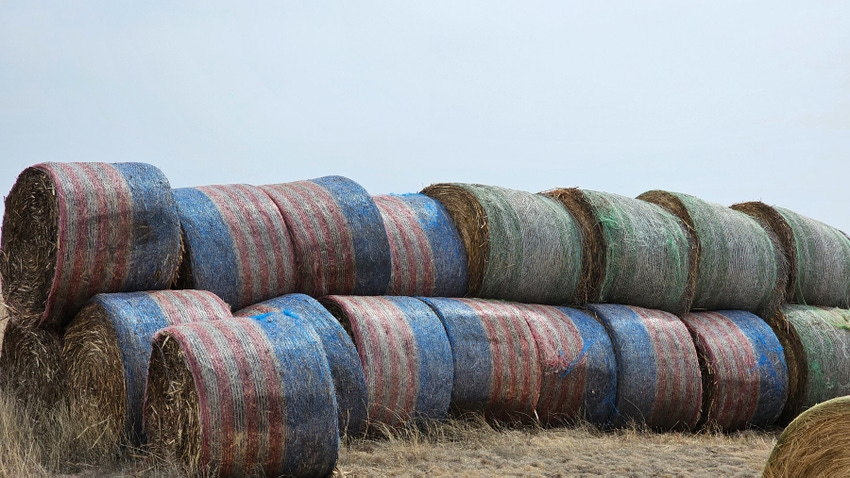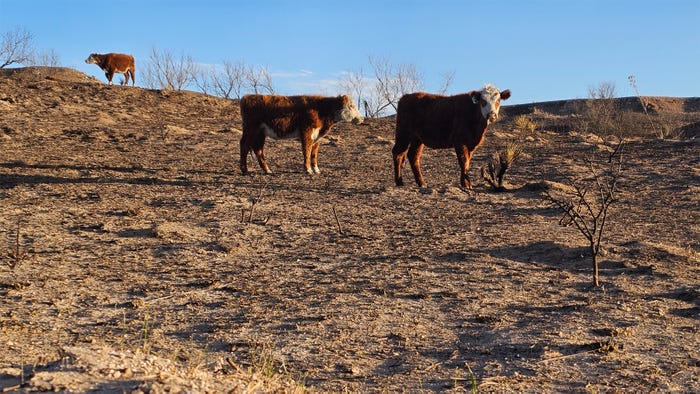
Truckloads of hay are rolling in from across Texas and beyond, bringing much-needed feed for cattle in the wake of more than 1.2 million acres of ranchland and pastures blackened by wildfires across the Texas Panhandle.
According to U.S. Department of Agriculture numbers, in most years, almost 100,000 head of cattle graze pastureland in Hemphill, Roberts, Gray, Hutchinson, Oldham, Potter and Carson counties. The wildfires have burned as much as 50% of these acres, with a greater percentage in some counties than others, and grassland won’t be available for grazing this season.

Pastures blackened by Texas Panhandle wildland fires. (Photo by Shelley E. Huguley)
Ranchers couldn’t make it without this much-needed donated hay. However, the livestock’s nutrition care doesn’t end there, according to two Texas A&M AgriLife Extension Service beef cattle specialists.
Daily feeding
Ron Gill, a professor in the Texas A&M College of Agriculture and Life Sciences Department of Animal Science, Bryan-College Station, said cows will consume about 2-2.6% of their body weight in dry hay depending on quality, so it is important to provide enough for their full daily intake.
“Depending on the number of cattle on hay, it may be necessary to put out numerous hay rings so cows have adequate access to hay, or possibly unrolling hay as a better option,” Gill said. “When feeding cows, it would be best to put out one ring per 10-15 cows. For these stressed cattle, you don’t want the boss cows keeping the weaker cattle from getting access to hay.”
Some other considerations:
Account for waste when calculating the amount of hay to feed daily. Depending on how the hay is fed to the cows, there can be as much as 50% wastage.
“Expect roughly 10-15% of the hay that is fed to be wasted in the current environmental conditions,” said Jason Smith, also an associate professor in the Department of Animal Science, Amarillo. “That number may be substantially greater if much-needed rainfall brings muddy conditions,”
If available, hay rings or “round-bale feeders” will likely cut waste in half. If cattle can be fed their daily limit of hay, waste can be reduced. Other strategies to minimize hay waste are to feed hay daily or every other day and only feed additional hay when that hay is cleaned up.
A better alternative might be unrolling their daily need every day; however, this may not be feasible with all the aspects of recovery going on. Feeding more hay than will be consumed in one to two days will result in greater waste.
Consider the class of cattle consuming hay. Young growing cattle, pregnant heifers approaching calving, and first-calf heifers and cows that are nursing calves are among the classes with the highest nutrient demands. These are followed by mature cows in late pregnancy and then by cows in early pregnancy, mature bulls and dry cows.
It may be possible to match better-quality hay to the cattle with higher demands and lower-quality hay to those with lower demands; however, there are likely some of each in many herds right now. Depending on the hay and the cattle, supplemental protein and energy may be required. While hay analysis is usually unavailable on donated hay, look at the stem-to-leaf ratio and color to estimate relative quality.
Cows being held to market soon may be managed differently than cows remaining in the herd for the longer term.
Productivity of thin cows with a body condition score of 4 or less going into the calving season will be impacted if their nutrient deficit is not addressed. These cows will struggle to raise their calves this year and are less likely to breed during the upcoming breeding season.
Hay type matters
The nutrient content of hay will depend upon several factors, such as its type and stage of maturity when it was harvested, Smith said.
“In many situations, the energy and protein content of the hay will be lower than that required by the cattle unless they are mid-gestation dry cows,” Smith said. “Supplementing to correct the nutrient deficiencies will be necessary in most cases, especially considering that most herds here either just began calving or will in the near future.”
Different supplements for different situations
As donations come in, there may be a wide variety of supplemental feedstuffs. Hay quality, stage and level of production, and size are the main factors influencing protein and energy supplementation needs.
Since hay quality may not be known in many situations, some general rules of thumb may help determine the best supplement for the specific situation. Low-protein, “commodity blend” type feeds and 20% cubes may be good options to help sustain the growth of growing cattle fed medium to high-quality hay.
Higher-protein cubes or “cake” — from something like a 28% distiller’s grains or “DDGS” cube to a 38% cottonseed meal-based cube — will be better suited to help fill the protein and energy voids left by relatively low-quality hay.
“Be mindful to not over supplement or overfeed cattle that are overly hungry,” Smith said. “They will overeat if they are overfed and could bloat or experience acidosis as a consequence.”
For cattle not being supplemented before the fire, begin by introducing a small amount, such as 0.25 to 0.5% of body weight, or roughly a few pounds of supplement per head per day for a mature 1,200-pound cow. Then gradually increase that daily amount every second or third day until the desired level of supplement is achieved.
Alfalfa hay may also be a good protein and energy supplement for many situations, but avoid feeding it free-choice when possible, particularly when cattle are hungry.
Smith encouraged producers not to overlook the importance of a complete mineral and vitamin supplement right now.
“Hay alone or hay and cake will not meet the mineral and vitamin requirements of cattle,” he said. “Minerals and vitamins provided through the supplement will help fuel the animal’s immune system, repair damaged tissues, and make it more resilient to stress. There are a lot of affected cattle that could benefit from those things right now.”
Test hay when possible
Gill and Smith said it would be prudent to test hay when possible, as some hay sources may contain prussic acid or nitrates. The risk of this is low in most of the perennial grasses and Conservation Reserve Program, CRP, type hay, and greatest in warm-season annuals like sorghum, sudangrass and sorghum x sudangrass. Hay can be tested to measure the level of nitrates or prussic acid and determine if levels in the hay are of concern.
When testing, sample several bales for the test rather than relying on a sample from one or two to represent the entire hay supply. Avoid grabbing samples by hand when possible. Core samples collected using a forage analysis probe will aid in collecting a representative sample. Testing is recommended for situations where the lot of hay will last for a substantial period.
Testing may not be possible if the hay is fed within a day or two. In that situation, limit the amount of the suspect hay provided daily to the cattle and feed other “low risk” hay with the suspect hay to reduce the risk of the cattle consuming a toxic level of nitrates or prussic acid. Feeding a protein and energy supplement will also help minimize the risk of a toxicity issue through dilution.
Young calves may need additional help
Since the spring calving season is just kicking off in the region, Smith said to pay close attention to newborn calves and calves that are born over the coming days and weeks. Cows with burned udders may not allow calves to nurse.
He said milk replacer is the only viable option for those calves unless nurse cows that will accept a calf are available. When possible, avoid plant protein-based milk replacers to ensure calves receive the nutrients they need in a form they can digest and absorb.
Smith also encourages producers to pay close attention to calves born soon after the fire.
“If the cow won’t let the calf nurse, and the calf doesn’t receive colostrum, the calf’s likelihood of survival is incredibly low,” he said. “It is critical that the calf receives colostrum within the first few hours of life. Waiting 24 to 48 hours after birth to get colostrum into a newborn calf is too long.”
Administer colostrum replacer or previously frozen colostrum that has been thawed using warm water to calves that can’t nurse as soon as possible to give them a fighting chance. If using a commercial product, Smith also encouraged producers to read the label and ensure that the product is intended to replace and not just supplement colostrum, and to also ensure that the calf receives the amount necessary to effectively replace colostrum that would have normally been provided by the calf’s dam.
Feeding for months
Typically, most livestock would be turned out onto pastures greening up with recent moisture, but many ranchers will find themselves feeding cattle throughout the summer, as pastures typically do not completely recover for as long as 12-18 months.
If resources are available to feed until range recovery occurs, it would be prudent to keep cattle on hay or alternative pasture for an extended time, Gill said. While cattle recovery is critical it is just as critical to consider range recovery following these intense wildfires.
As producers look beyond the short-term situation of just getting daily feed in front of the cattle, wheat pasture may be an alternative, but Gill recommended using caution when turning hungry cattle out on wheat.
Grass tetany and bloat are real concerns this time of year. Make sure cattle are on a mineral supplement to help augment these risks and that they are full of hay before being placed on wheat pasture. Smith said feeding a supplement that contains an ionophore, such as monensin, or another bloat preventative, such as poloxalene, will also help to minimize the bloat risk.
Gill also said feeding a high-energy supplement such as corn or a corn-based mix can alleviate some risk and increase weight gain in cows and growing cattle.
More preparedness and recovery information may be found on the Disaster Assessment and Recovery website. Safety tips and wildfire resources are also available on the Texas Ready website and the Texas A&M Forest Service website.
About the Author(s)
You May Also Like




